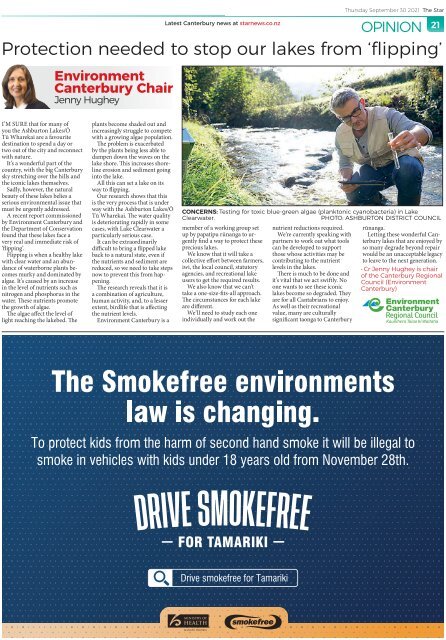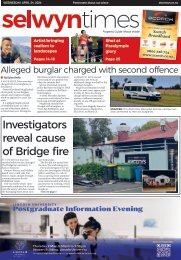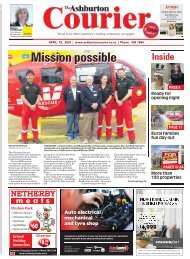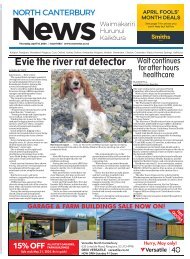The Star: September 30, 2021
Create successful ePaper yourself
Turn your PDF publications into a flip-book with our unique Google optimized e-Paper software.
OPINION 21<br />
Latest news at starnews.co.nz<br />
ince Environment Canterbury<br />
Protection climate-change needed emergency to stop our lakes from ‘flipping’<br />
by sea-level rise this century and threatened and facing increased<br />
our productive and protected land pressures due to river system<br />
Environment<br />
jeopardised by the arrival and change.<br />
spread of new, exotic weeds and Wetlands are also ecosystems<br />
Canterbury Chair<br />
pests from warmer climates. at-risk nationally and regionally,<br />
Jenny Hughey<br />
All these eventualities have degraded by draining, damming<br />
to be planned and prepared for, and diversion affecting their<br />
and enhance that work.<br />
fleet hybrid or long-range electric<br />
and Environment Canterbury ability to sequester carbon,<br />
That work included setting by 2022. Carbon emissions from<br />
will remain in the vanguard of cleanse freshwater and mitigate<br />
I’M SURE that for many of plants become shaded out and<br />
up a climate-change integration air travel across the organisation<br />
these climate change efforts. flooding, as well as impacting on<br />
you the Ashburton Lakes/Ō increasingly struggle to compete<br />
programme Tū Wharekai in are the a Long-term favourite Plan with are a offset growing via our algae own population.<br />
One example is the $40 million biodiversity and mahinga kai.<br />
biodiversity<br />
2018-28, destination ensuring to spend climate a day or change programmes.<br />
<strong>The</strong> problem is exacerbated<br />
Waimakariri River flood<br />
With biosecurity, we are<br />
was two actively out of the considered city and reconnect across by the According plants being to a less Madworld able to<br />
protection project, completed putting greater emphasis on the<br />
report<br />
workstreams, with nature. increasing visibility dampen in 2019, down our gross the waves emissions the late last year. <strong>The</strong> network of risks of new pests establishing<br />
were<br />
of It’s the a science wonderful and part what of we the know lake 2253 shore. tonnes This of increases carbon dioxide shoreline<br />
(CO2) erosion equivalent, and sediment compared going protect half a million people and temperatures, changing soils and<br />
floodgates and stopbanks will in Canterbury. Warming<br />
about country, the with impact the of big climate Canterbury<br />
with<br />
change sky stretching on Canterbury, over the hills and liaising and into removals the lake.<br />
$8 billion of community and new land uses mean new weeds<br />
of 7883 tonnes of CO2-<br />
on the the iconic issue lakes with themselves. iwi and regional equivalent All this can through set a lake our on efficiency its business assets from a possible especially, will be able to gain a<br />
partners,<br />
Sadly, however,<br />
other local<br />
the<br />
authorities<br />
natural way<br />
efforts<br />
to flipping.<br />
“super flood”.<br />
better foothold across the region.<br />
and from forestry planting <strong>The</strong> last major flood was in<br />
and<br />
beauty<br />
central<br />
of these<br />
government.<br />
lakes belies a<br />
across<br />
Our research<br />
2700 hectares.<br />
shows that this<br />
More broadly, we have to<br />
serious environmental issue that is the very process that is under December 1957, when parts curb reliance on fossil fuels and<br />
As an organisation, we have <strong>The</strong> changing climate will pose<br />
must be urgently addressed. way with the Ashburton Lakes/Ō of Coutts Island in Belfast and find environmentally suitable<br />
also made significant progress in many risks to life and livelihood CONCERNS: Testing for toxic blue-green algae (planktonic cyanobacteria) in Lake<br />
A recent report commissioned Tū Wharekai. <strong>The</strong> water quality Kainga were swamped by river alternatives, such as electricity and<br />
addressing our own greenhousegas<br />
the emissions, Department with of Conservation<br />
our<br />
cases, we have with seen Lake how Clearwater occasional, a member metres of per a working second group (cumecs). set nutrient transport. reductions required. rūnanga.<br />
in Canterbury. In recent years Clearwater.<br />
PHOTO: ASHBURTON DISTRICT COUNCIL<br />
by Environment Canterbury and is deteriorating rapidly in some flow peaking at 3990 cubic hydrogen, to power our public<br />
Christchurch found that these building lakes face receiving a a particularly but extreme, serious weather case. events have up by <strong>The</strong> papatipu protection rūnanga scheme to urgently<br />
designed find a way to defend to protect Christchurch these partners Lowndes to work retired out what as chair tools of terbury lakes that are enjoyed by<br />
has been We’re When currently my speaking predecessor with Steve Letting these wonderful Can-<br />
“market-leading” very real and immediate energy risk efficiency of had It can huge be extraordinarily<br />
effects on residents and<br />
rating ‘flipping’. of 5.0 out of 6 in the year difficult infrastructure to bring around a flipped the lake South precious from lakes. a flood of as much as 6500 can be this developed council to late support last year, he so many degrade beyond repair<br />
to Flipping February is on when the a National healthy lake back Island. to a natural state, even if We cumecs. know that it will take a those highlighted whose activities some may of the be big would be an unacceptable legacy<br />
Australian with clear water Built Environment<br />
and an abundance<br />
of System waterborne New Zealand. plants be-<br />
reduced, along the so Marlborough we need to take coast steps and iwi, leadership the local council, of biodiversity statutory and levels optimistic in the lakes. we would be able to • Cr Jenny Hughey is chair<br />
the nutrients <strong>The</strong> driest and parts sediment of our region, are collective Environment effort between Canterbury’s farmers, contributing changes to on the the nutrient way. He was to leave to the next generation.<br />
Rating<br />
comes <strong>The</strong> building’s murky and features dominated include by now across to prevent much of this the from Canterbury happening.<br />
Plains, are expected to get even users underpinned to get the required by climate-change results. it’s vital climate that we change act swiftly. and sustainability.<br />
No Council (Environment<br />
agencies, biosecurity and recreational programmes lake is also <strong>The</strong>re deal is with much the to “pressing be done and issues” of the Canterbury Regional<br />
184 algae. solar It’s panels caused which by an increase can<br />
generate in the level more of nutrients than 55,000 such as drier. <strong>The</strong> research North-westerly reveals that storms it is are We concerns. also know that we can’t one wants I share to see his these confidence. iconic As a Canterbury)<br />
kilowatt nitrogen hours and phosphorus of electricity in per the a combination predicted to become of agriculture, more intense, take a<br />
year.<br />
with torrential alpine rainstorms<br />
Canterbury’s one-size-fits-all distinct approach. braided lakes community, become so degraded. and as a council, <strong>The</strong>y<br />
water. <strong>The</strong>se nutrients promote<br />
<strong>The</strong>re has been a 26% reduction turning our braided rivers into<br />
rivers and unique wetlands face we are taking some bold steps to<br />
the growth It’s of algae. a year human since activity, and, to a Environment lesser <strong>The</strong> circumstances for each lake are for all Cantabrians to enjoy.<br />
extent, birdlife that is affecting many challenges. <strong>The</strong> rivers form<br />
Canterbury<br />
are different.<br />
As well<br />
ensure<br />
as their<br />
we<br />
recreational<br />
are in a better place to<br />
per <strong>The</strong> staff algae member affect in the emissions level of the roaring nutrient rapids, levels. fuelling landslides<br />
We’ll<br />
a vital<br />
need<br />
ecological<br />
to study<br />
link<br />
each<br />
and<br />
one<br />
provide<br />
value,<br />
cope<br />
many<br />
with<br />
are<br />
the<br />
culturally<br />
changing climate<br />
since light reaching <strong>30</strong> declared June 2010. the lakebed. We now <strong>The</strong> have a climate-change emergency<br />
and Environment causing widespread Canterbury erosion. is a individually an abundant and food work supply out the and significant<br />
and the<br />
taonga<br />
tests<br />
to<br />
it will<br />
Canterbury<br />
set us. But<br />
access to electric and hybrid<br />
Canterbury’s coastal<br />
nesting grounds for 26 species of there will always be a need to do<br />
vehicles JENNY and hope HUGHEY to have explains half our what communities will be threatened native birds – most classified as by sea-level more. rise this century and<br />
the council has been doing.<br />
<strong>The</strong> formal declaration of a<br />
state of climate emergency across<br />
Canterbury was one of the most<br />
serious, and colourful, moments<br />
in the regional council’s more than<br />
<strong>30</strong>-year history.<br />
A year ago this Saturday,<br />
at 11.49am, Environment<br />
Canterbury became New Zealand’s<br />
first council to proclaim such an<br />
emergency, formally dedicating<br />
itself to consideration of climate<br />
change at the heart of all it does.<br />
<strong>The</strong> declaration highlighted<br />
that all the work Environment<br />
Canterbury does – from<br />
freshwater management to<br />
biodiversity and biosecurity,<br />
transport and urban development<br />
to air quality, and also regional<br />
leadership – has a climate change<br />
focus.<br />
Currently, under the Resource<br />
Management Act, regional<br />
councils are required only to adapt<br />
to climate change, not mitigate<br />
it – that responsibility is the<br />
Government’s, but could change.<br />
Even in ‘adapt mode’ many<br />
of Environment Canterbury’s<br />
existing policies and plans already<br />
contribute to reduced emissions.<br />
In declaring the climate<br />
emergency, the Council noted it<br />
would continue to show leadership<br />
on climate-change and do so<br />
without adding new programmes<br />
at ratepayers’ expense. It also gave<br />
staff a clear mandate to continue<br />
and enhance that work.<br />
That work included setting<br />
up a climate-change integration<br />
programme in the Long-term Plan<br />
2018-28, ensuring climate change<br />
was actively considered across<br />
workstreams, increasing visibility<br />
of the science and what we know<br />
about the impact of climate<br />
change on Canterbury, and liaising<br />
on the issue with iwi and regional<br />
partners, other local authorities<br />
and central government.<br />
As an organisation, we have<br />
also made significant progress in<br />
addressing our own greenhousegas<br />
emissions, with our<br />
Christchurch building receiving a<br />
“market-leading” energy efficiency<br />
rating of 5.0 out of 6 in the year<br />
to February on the National<br />
Australian Built Environment<br />
Rating System New Zealand.<br />
<strong>The</strong> building’s features include<br />
184 solar panels which can<br />
generate more than 55,000<br />
kilowatt hours of electricity per<br />
year.<br />
<strong>The</strong>re has been a 26% reduction<br />
per staff member in emissions<br />
since <strong>30</strong> June 2010. We now have<br />
access to electric and hybrid<br />
vehicles and hope to have half our<br />
Environment<br />
Canterbury Chair<br />
Jenny Hughey<br />
fleet hybrid or long-range electric<br />
by 2022. Carbon emissions from<br />
air travel across the organisation<br />
are offset via our own biodiversity<br />
programmes.<br />
According to a Madworld report<br />
in 2019, our gross emissions were<br />
2253 tonnes of carbon dioxide<br />
(CO2) equivalent, compared with<br />
removals of 7883 tonnes of CO2-<br />
equivalent through our efficiency<br />
efforts and from forestry planting<br />
across 2700 hectares.<br />
<strong>The</strong> changing climate will pose<br />
many risks to life and livelihood<br />
in Canterbury. In recent years<br />
we have seen how occasional,<br />
but extreme, weather events have<br />
had huge effects on residents and<br />
infrastructure around the South<br />
Island.<br />
<strong>The</strong> driest parts of our region,<br />
along the Marlborough coast and<br />
across much of the Canterbury<br />
Plains, are expected to get even<br />
drier. North-westerly storms are<br />
predicted to become more intense,<br />
with torrential alpine rainstorms<br />
turning our braided rivers into<br />
roaring rapids, fuelling landslides<br />
and causing widespread erosion.<br />
Canterbury’s coastal<br />
communities will be threatened<br />
our productive and protected land<br />
jeopardised by the arrival and<br />
spread of new, exotic weeds and<br />
pests from warmer climates.<br />
All these eventualities have<br />
to be planned and prepared for,<br />
and Environment Canterbury<br />
will remain in the vanguard of<br />
these climate change efforts.<br />
One example is the $40 million<br />
Waimakariri River flood<br />
protection project, completed<br />
late last year. <strong>The</strong> network of<br />
floodgates and stopbanks will<br />
protect half a million people and<br />
$8 billion of community and<br />
business assets from a possible<br />
“super flood”.<br />
<strong>The</strong> last major flood was in<br />
December 1957, when parts<br />
of Coutts Island in Belfast and<br />
Kainga were swamped by river<br />
flow peaking at 3990 cubic<br />
metres per second (cumecs).<br />
<strong>The</strong> protection scheme has been<br />
designed to defend Christchurch<br />
from a flood of as much as 6500<br />
cumecs.<br />
Environment Canterbury’s<br />
leadership of biodiversity and<br />
biosecurity programmes is also<br />
underpinned by climate-change<br />
concerns.<br />
Canterbury’s distinct braided<br />
rivers and unique wetlands face<br />
many challenges. <strong>The</strong> rivers form<br />
a vital ecological link and provide<br />
an abundant food supply and<br />
nesting grounds for 26 species of<br />
native birds – most classified as<br />
Thursday <strong>September</strong> <strong>30</strong> <strong>2021</strong> <strong>The</strong> <strong>Star</strong><br />
threatened and facing increased<br />
pressures due to river system<br />
change.<br />
Wetlands are also ecosystems<br />
at-risk nationally and regionally,<br />
degraded by draining, damming<br />
and diversion affecting their<br />
ability to sequester carbon,<br />
cleanse freshwater and mitigate<br />
flooding, as well as impacting on<br />
biodiversity and mahinga kai.<br />
With biosecurity, we are<br />
putting greater emphasis on the<br />
risks of new pests establishing<br />
in Canterbury. Warming<br />
temperatures, changing soils and<br />
new land uses mean new weeds<br />
especially, will be able to gain a<br />
better foothold across the region.<br />
More broadly, we have to<br />
curb reliance on fossil fuels and<br />
find environmentally suitable<br />
alternatives, such as electricity and<br />
hydrogen, to power our public<br />
transport.<br />
When my predecessor Steve<br />
Lowndes retired as chair of<br />
this council late last year, he<br />
highlighted some of the big<br />
changes on the way. He was<br />
optimistic we would be able to<br />
deal with the “pressing issues” of<br />
climate change and sustainability.<br />
I share his confidence. As a<br />
community, and as a council,<br />
we are taking some bold steps to<br />
ensure we are in a better place to<br />
cope with the changing climate<br />
and the tests it will set us. But<br />
there will always be a need to do<br />
more.


















